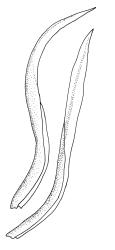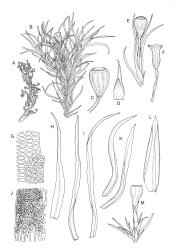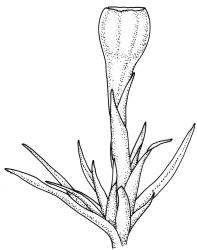- ≡ Anictangium lapponicum Hedw., Sp. Musc. Frond. 40 (1801)
- ≡ Amphoridium lapponicum (Hedw.) Schimp., Syn. Musc. Eur. 247 (1860)
Plants small to medium-sized, yellow-green above, brown below. Stems as per genus, commonly c. 15 mm in N.Z. material. Leaves erect-spreading when moist, strongly contorted when dry, linear-lanceolate and narrowly acute, entire, plane at margins, mostly c. 3 mm in upper part of shoots; upper laminal cells oblate or subquadrate, rounded, incrassate, mostly 9–12 µm in greater dimension, with numerous (c. 8 or more over each lumen), small (c. 3 µm diam.), and round papillae over the lumen and the contiguous cell walls; papillae apparently becoming elliptic and non-pigmented towards the insertion and in the juxtacostal cells; basal cells gradually differentiated towards insertion, becoming oblong-rectangular and smooth, pale or golden, occasionally papillose nearly to the insertion; alar and marginal cells not differentiated. Costa strong and subpercurrent, the abaxial surface with elongate and smooth superficial cells nearly to the apex, the adaxial surface with ± quadrate and papillose superficial cells, with a single layer of median guide cells.
Autoicous. Perichaetial leaves differentiated, tubulose and sheathing the seta, oblong-elliptic or oblong-lanceolate, rather abruptly narrowed to a broadly or narrowly acute apex, 1.2–2.0 mm, ending at or below the lower urn. Perigonia on short stalked buds a short distance below the perichaetium, but some antheridia also naked among outer perichaetial leaves. Setae 1 per perichaetium, 1.0–1.5 mm (excluding vaginula), straight; capsules emergent to short exserted relative to the inner perichaetial leaves (when moist), c. 0.9–1.3 × 0.6 mm. Spores 12–15 µm.
Brotherus 1924, fig. 156; Crum & Anderson 1981, fig. 324, A–E; Magill & van Rooy 1998, fig. 136, 13–25.
Amphidium lapponicum is most likely confused with its congener, A. cyathicarpum; the nature of the perichaetial leaves is the most reliable means of distinguishing between these two species. The elliptic papillae, which occur over the laminal cell walls as well as the cell lumens, give the lamina a distinctive papillose-striolate appearance under the compound microscope, but these are a feature of all species of Amphidium. Confusion can also occur between the present species and unrelated species, which are discussed under A. cyathicarpum.
NI: Taranaki (near Manganui Lodge, near Stratford Mountain House), Wellington (Mt Ruapehu); SI: Nelson (Lake Peel, St Arnaud Range), Canterbury (Temple Basin, Broad Stream, near Lake Lyndon, De la Bêche Ridge), Westland (upper Ōtira Valley).
Bipolar. Widespread in the northern hemisphere; reported from Macaronesia, northern and southern Africa by Magill & van Rooy (1998), and from Chile by Smith (2004).
Apparently restricted to relatively cation-rich outcrops of greywacke and volcanic rocks. One doubtful collection from the Eyre Range in Southland occurred on schist. Ranging from 880 (Broad Stream, Canterbury) to c. 1525 m (De la Bêche Ridge) and commonly associated with Distichium capillaceum.
Amphidium lapponicum is very difficult to distinguish in the field from A. cyathicarpum, and consequently the distribution given above may markedly underestimate its distribution. There appear to be no published records of A. lapponicum from either Tasmania or mainland Australia.
Although Sainsbury (1955) clearly suspected the occurrence of this species in N.Z., A. lapponicum was first recorded here by Bartlett (1984) on the basis of two collections determined by D.H. Vitt. Material of one of these specimens (J.K. Bartlett 18437 from Mt Cobb, WELT M007474) has been examined; it lacks both sporophytes and perichaetia, and its specific identity therefore cannot be confidently confirmed.







